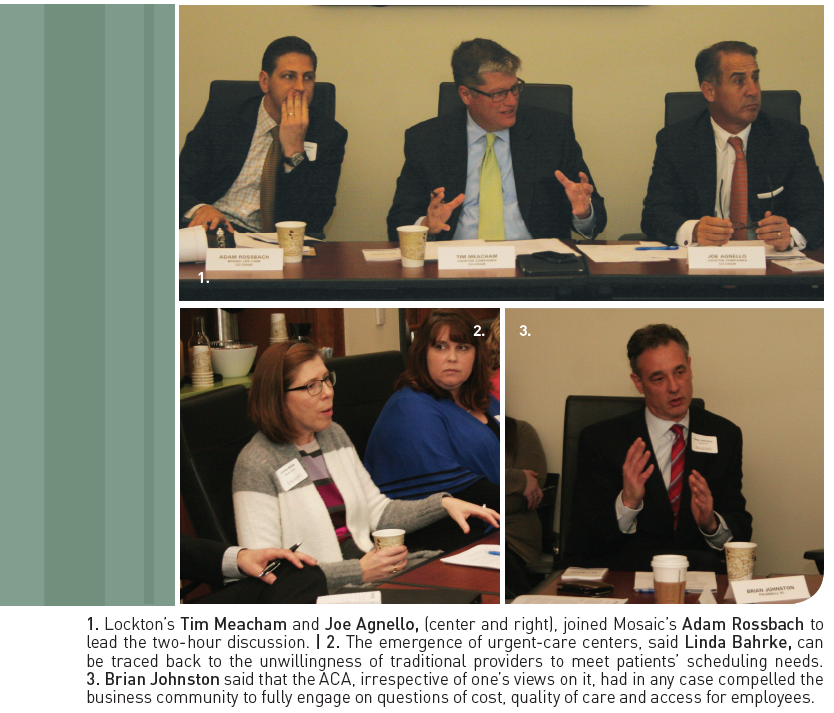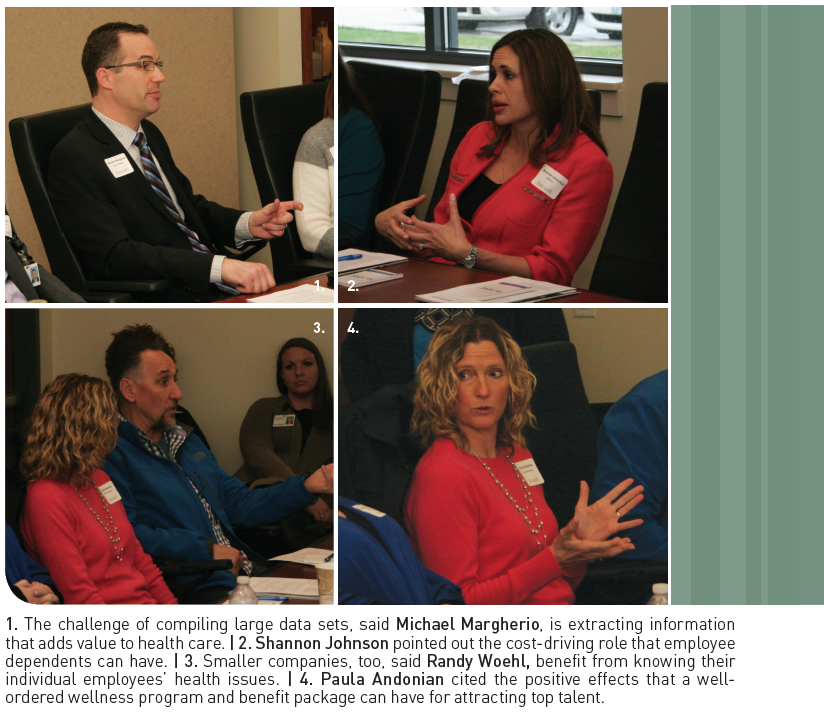HOME | ABOUT US | MEDIA KIT | CONTACT US | INQUIRE
HOME | ABOUT US | MEDIA KIT | CONTACT US | INQUIRE


Over the course of three meetings starting in December, Mosaic Life Care and Ingram’s teamed up with health-insurance interests from Holmes Murphy & Associates, CBIZ and Lockton Companies to invite insurers, providers, and employers—large and small—to explore the major trend lines in health care nationally and in this region, and some of the options available to executives of companies that provide paid health insurance as a benefit to employees.
The third session on March 24, like the two before it, offered some interesting insights into an evolving health-care marketplace that promises to remain fraught with change. Among the key points addressed by nearly a score of executives at the Mosaic Life Care Shoal Creek clinic were:
• The unabated employer concerns about cost, access to care and quality of outcomes.
• The need for more primary care to corral costs.
• The powerful changes in delivery methods now taking place as more urgent-care clinics open, offering a wider range of services, and greater access to them.
• The efforts by employers to more fully engage their staff to create a healthier, happier and more productive work force.
• The way that Big Data is changing … everything.
It was fitting then, that Brian Johnston, who specializes in health-care law for Polsinelli PC, opened the discussion about challenges in health care with a wry observation: “We’ve got two hours, right?” But he boiled that down to employer concerns on two fronts: compliance and its own set of costs, and how to meet employee expectations for health-care coverage and still remain in business.
Randy Woehl, human resources manager for Cartwright Companies, lives those challenges daily. “Being a small company, about 120 employees, we’re really trying to drive lifestyle changes throughout our wellness program,” he said. “We’re starting to see some of the benefits of that.” He noted that an effective program that helps employees remain healthier and more productive can be a competitive advantage in recruiting top people.
Paula Andonian, payroll and benefits manager for Boulevard Brewing Co., said a continuing challenge is getting employees to understand how health-care coverage relates to them personally. “The more educated employees can be about their own health, the better experience they’ll have and the happier they’ll be,” she said.
And that, most in attendance agreed, should lead companies to embrace policies and plans that encourage greater employee engagement with primary-care physicians. By some counts, nearly half of those covered by health-care plans haven’t taken even the simple step of choosing a family doctor.
 And yet, said Linda Bahrke, administrator for Mosaic Life Care’s accountable care organization, “that is the least expensive level—it avoids ICU, ER and in-patient visits.” Studies show, she said, that if gaps in basic care can be identified early, connecting patients to the right caregiver will lower overall costs.
And yet, said Linda Bahrke, administrator for Mosaic Life Care’s accountable care organization, “that is the least expensive level—it avoids ICU, ER and in-patient visits.” Studies show, she said, that if gaps in basic care can be identified early, connecting patients to the right caregiver will lower overall costs.
But to get to that step—helping employees align with the right provider—companies need to understand the individual health challenges their employees face; one-size-fits-all policies are self-defeating, executives say. For Paula Andonian, the first step must be a wellness program that educates employees and identifies those health issues. Annual biometrics, generated though on-site clinics, are a good approach, she said. “There’s a lot of education needed about health to make people realize that ‘maybe I need to see a doctor,’ ” she said.
Randy Woehl recalled an initial visit from Mosaic Life Care’s Mobile Clinic where “people saw their blood pressures off the charts,” he said, including a case where one person was sent to the hospital immediately to address the risk of stroke. “I think it got that person’s attention,” he said, “They’re still alive, and healthier than they’ve ever been.”
Those baselines, employers said, allow for incremental expansion of programs to reach more employees, at deeper levels of engagement. But simply knowing the biometrics was a huge breakthrough. As big a challenge as that’s been, said Shannon Johnson, human-resources manager for UMB Bank, the issue is coverage and costs for employees’ dependents. “Our highest claims don’t necessarily come from employees,” she said. “So how do I get their partners and dependents? That’s been a big target for us.” But, as with employees, the bank’s wellness-focused outreach to those individuals targets cost drivers like cases of diabetes, obesity, musculoskeletal conditions and cancer, she said. And the carrot-and-stick approach used for employees is being extend-ed to their dependents, as well.
Of course, reliance on lower-cost visits to primary-care physicians or provider teams at patient-centered medical homes depends on a supply of those caregivers, something that’s been in decline as larger hospital systems have bought up private physician practices.
“We want to help maintain independent private-practice physicians—we think that’s important,” said Patti Groz-danich, a vice president with United HealthCare. “We’ve seen movement over the years of hospital systems’ employing more physicians, but we need a mix.” Michael Margherio, her colleague at UHC who works on the sales side, noted that “over the last three or four years, employers have been taking a more aggressive role in bringing care on-site,” with mobile clinics, health screenings and other workplace events that have helped address the access issue and potentially, longer-term, some of the costs concerns.
Those overtures, Brian Johnston said, were an important step. But “how do we move that relationship with the primary-care physician by getting people off their butts to go do it?” he asked. “The carrot is now more stick than it used to be because it does work.”
The role of technology, and Big Data in particular, looms large in health care, as executives noted from several perspectives.
“The investment we have made in data analytics is off the charts,” said Joe Agnello, president and producer for Lockton. “We have to have meaningful analytics to share with clients and show them what we can do with it. The challenge we have to our team is: So what? What are the innovative things you are doing, and how is using the great data that’s becoming available helping to drive down cost?”
David Klasnik, managing director for Washington-based The Advisory Board, said part of his consultancy’s mission entails taking claims-level data and making it easier for health systems to use. “We figure out what subset of patients is driving the highest cost, where the opportunities are for improved utilization, whether that’s through drug or procedural, and ultimately helping organizations” laser in on the areas where they perform best, he said.
His colleague, Brendan McDonald, pointed out that health care as a sector “in general lags the vast majority of industries in use of data to drive business decisions” about spending. But now, executives are coming to terms with both descriptive analytics and what the data mean, as well as predictive analytics to figure out what challenges might be ahead. “They are becoming much more advanced in using data, something health care is not historically good at,” he said.
Like Lockton, UHC has focused “a ton of resources on growing data capabilities,” said Michael Margherio. “Give me more data, give me more data, but we challenge our folks to do exactly the same things: Tell us what employers can do with it, how they can use it, how it can help them make decisions.” Among the more innovative applications, he noted, was within health-care systems themselves, since they can integrate benefits for large work forces with care delivery and consumer experience all within their own organizations. “That’s becoming a model for other business,” he said.
Angela Bedell, executive director of the Kansas City Medical Society, said broader issues of cost control need to be grounded in specific goals and outcomes. She cited her own experience at the end of 2013, challenging her staff to increase physician membership in the coming year, and offering specific bonus amounts up front. Result? The memberships quadrupled in 2014, she said.
“If I had said to the team, just work on membership, grow it big and fast, I’ll pay you something and tell you how much it will be later, I’m not sure we would have grown the same way,” Bedell said. “We need that same clarity with physicians, but it’s tricky.”
All of this change is altering the very nature of relationships between health-care stakeholders, from the patients to the physicians, from the insurers to the employers. Patti Grozdanich said that “in the old days, we’d get in the room and hammer each other, providers and payers, over every unit of cost, every penny.” Moving past that, she said, has led to a focus on helping employers find greater value in their health-care spend.
“The best part about this conversation,” said Brian Johnston, “is that, say what you want about the Affordable Care Act, good or bad, it has increased the level of strategic engagement from the business perspective; I don’t care what size it is.” Michael Margherio echoed that: “The kinds of conversations employers are having with payers, and having directly with providers, are a very different conversation than they were having 10 years ago, even five years ago.”
For decades, when employers have looked at health-care plans, said Paula Andonian, “I’m not sure they’ve been seen as anything but a necessary evil, as opposed to opportunities to define themselves: “‘This is who we are, this is how we operate, this is what we do: How we can enrich the lives of our employees?’ ”
It’s really taking a look from a different viewpoint, she said, “with how they can make this more effective for employees, how they can manage the cost and what can they do that’s different from the way we’ve always done it.”